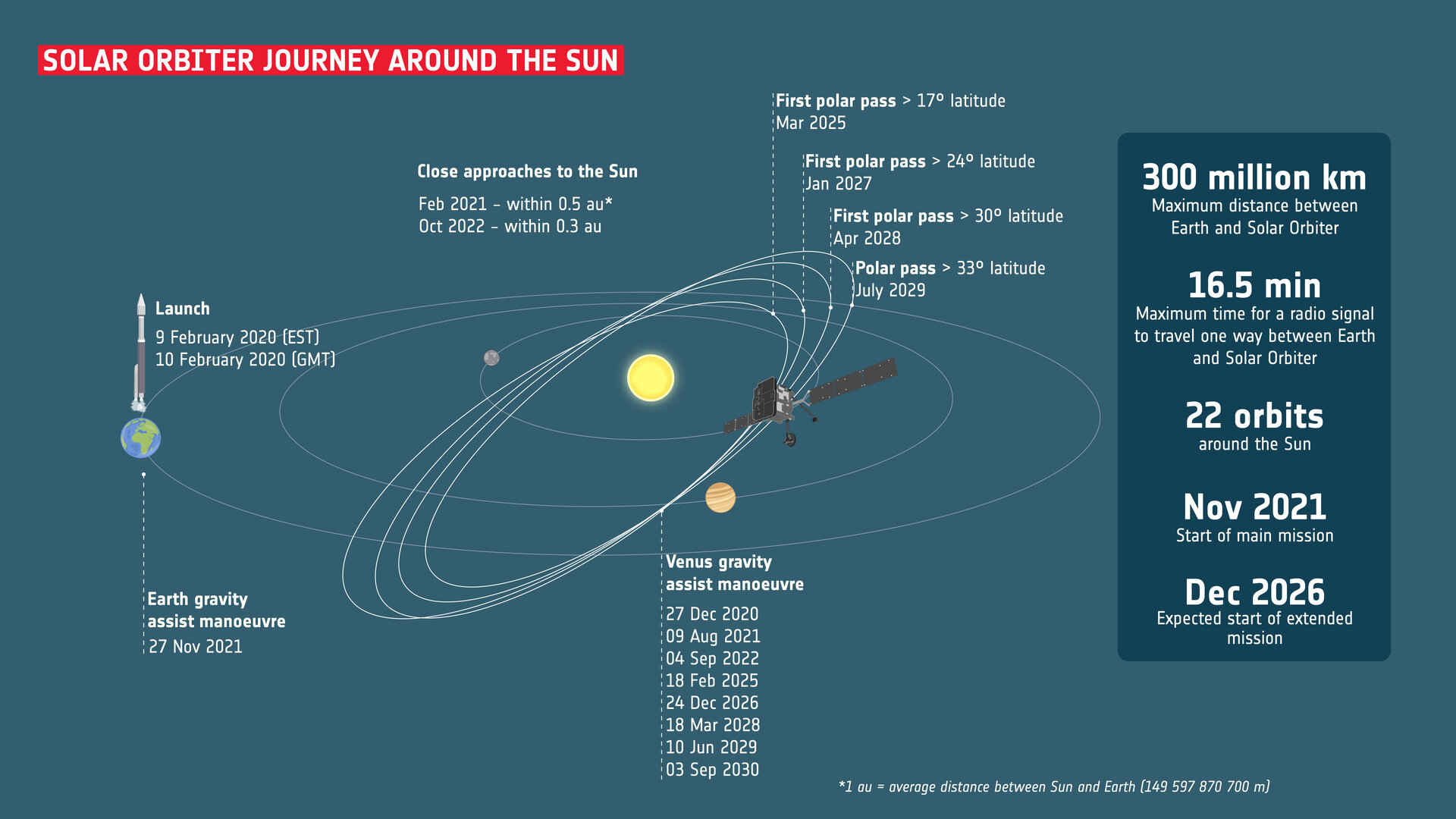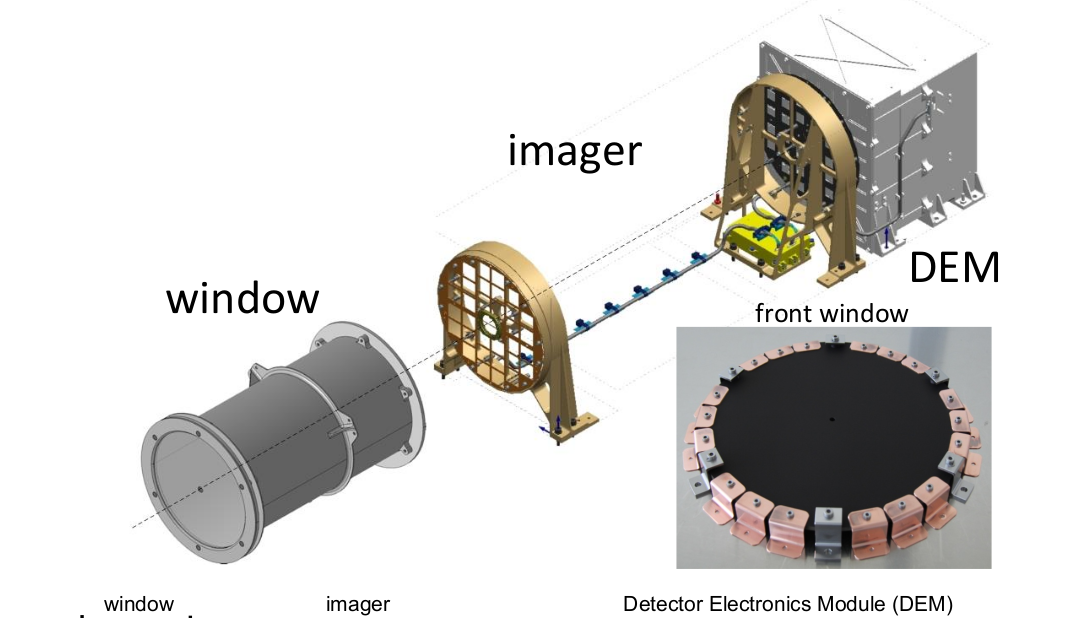Solar Orbiter
A Satellite’s Journey to the Sun
Solar Orbiter is the most complex scientific laboratory ever to have been sent to the Sun. Although our life-giving star has been an object of scientific interest for centuries, its behaviour still presents a puzzle for scientists. Solar Orbiter will take images of the Sun from closer than any spacecraft before and for the first time look at its uncharted polar regions. By combining observations from Solar Orbiter’s six remote-sensing instruments and four sets of in situ instruments, scientists hope to find answers to some profound questions: What drives the Sun’s 11-year cycle of rising and subsiding magnetic activity? What heats up the upper layer of its atmosphere, the corona, to millions of degrees Celsius? What drives the generation of solar wind? What accelerates the solar wind to speeds of hundreds of kilometers per second? And how does it all affect our planet?
Launch date: February 2020
Mission duration: 7 years (nominal) + 3 years (extended)
Mission highlights: Aims to address questions of solar physics relating to how the Sun creates and controls the Heliosphere and why solar activity changes with time
The closest space orbit to the Sun: 42 million kilometers.
The closest distance to the Sun: Unique elliptical orbit around the sun, with distances varying from 0.3 - 1 AU.

The Spectrometer/Telescope for Imaging X-rays (STIX)


The Spectrometer Telescope for Imaging X-rays (STIX) on Solar Orbiter is a hard X-ray imaging spectrometer covering the energy range from 4 to 150 keV. STIX observes hard X-ray bremsstrahlung emissions from solar flares and therefore provides diagnostics of the hottest (~ 10 MK) flare plasma while quantifying the location, spectrum, and energy content of flare-accelerated nonthermal electrons.
To accomplish this, STIX applies an indirect bigrid Fourier imaging technique using a set of tungsten grids (at pitches from 0.038 to 1 mm) in front of 32 coarsely pixelated CdTe detectors to provide information on angular scales from 7 to 180 arcsec with 1 keV energy resolution (at 6 keV). The imaging concept of STIX has intrinsically low telemetry requirements and it is therefore well-suited to the limited resources available to the Solar Orbiter payload. To further reduce the downlinked data volume, STIX data are binned on board into 32 selectable energy bins and dynamically-adjusted time bins, with a typical duration of 1 second during flares.
Through hard X-ray diagnostics, STIX provides critical information for understanding the acceleration of electrons at the Sun and their transport into interplanetary space and for determining the magnetic connection of Solar Orbiter back to the Sun. In this way, STIX serves to link Solar Orbiter’s remote and in-situ measurements.
The STIX instrument was developed in Switzerland and led by FHNW.
For more details about STIX instrument, please refer to the instrument paper.
STIX specification summary
STIX Data Center – an automated data processing, management and visualization platform for STIX
The STIX Data Center is a user-friendly platform that automatically processes, manages and monitors telemetry data from the Spectrometer/Telescope for Imaging X-rays (STIX) on the Solar Orbiter spacecraft. Developed by the STIX team, this system efficiently handles STIX telemetry data, supporting both instrument operations and scientific research.
Key Features:
Automated Data Processing: The STIX Data Center receives data directly from the European Space Agency (ESA) and transforms it into various usable formats, eliminating manual intervention.
Automated Data Quality Monitoring: The system continuously monitors the incoming data stream for anomalies and inconsistencies, ensuring the reliability and accuracy of scientific results.
Automated instrument In-flight Health Monitoring: The STIX Data Center keeps a watchful eye on the health of the STIX instrument itself, providing real-time status updates and alerting researchers to any potential issues. This proactive monitoring helps to safeguard the instrument and optimize its performance.
Cloud-Based Deployment: The entire system is hosted on a secure cloud server at the University of Applied Sciences and Arts Northwestern Switzerland (FHNW).
Modular Design: The STIX Data Center's modular architecture ensures easy adaptation for future space missions with minimal changes.
Broader Applicability: With minor adjustments, the system can be applied to other scientific data processing needs, such as large research facilities and Internet of Things (IoT) applications.
Web-Based Data visualization and interactive data analysis tools: Analysis reports, instrument health data, and scientific results are all conveniently displayed through responsive web interfaces, accessible from any device. The website also provides various interactive data analysis tools for users. Furthermore, these interfaces also integrate instrument operation tools, allowing researchers to interact with and control the STIX instrument remotely.
The development of the STIX data center was spearheaded by Dr. Hualin Xiao., with valuable support and contributions provided by the STIX team.
For a deeper dive into the STIX Data Center's details, please refer to our paper: https://doi.org/10.1051/0004-6361/202346031
Links
